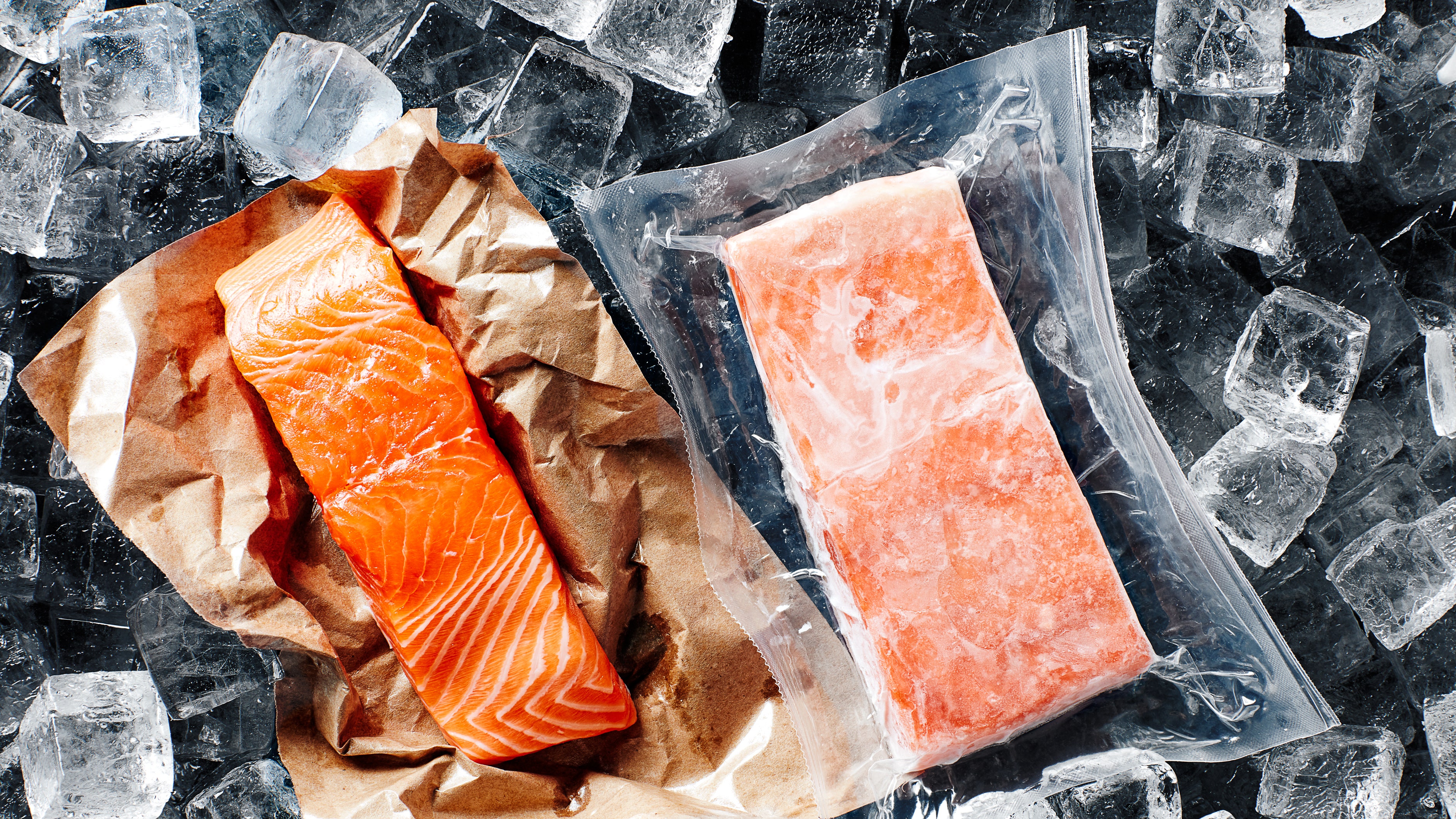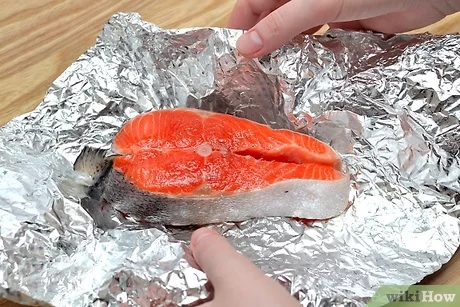Understanding The Importance Of Safely Thawing Salmon

Properly thawing salmon is crucial to ensure its safety and maintain its quality. Thawing salmon incorrectly can lead to bacterial growth and compromise the taste and texture of the fish. By using safe thawing methods, like defrosting in the microwave, you can effectively thaw salmon in a quick and convenient manner. Thawing salmon in the microwave can save time, but it’s important to follow guidelines and monitor the process to prevent overcooking. Other thawing methods, such as refrigerator thawing or using cold water, may take longer but offer more control over the thawing process.
I-1 The Risks Of Improper Salmon Thawing
Improper salmon thawing can pose serious risks to both food safety and the quality of the fish. Thawing salmon at room temperature or using hot water can create an ideal environment for bacterial growth, increasing the risk of foodborne illnesses. Additionally, thawing salmon too quickly or using high heat methods like a microwave can lead to overcooking and a dry, rubbery texture. It is important to thaw salmon slowly and under controlled conditions to ensure that it remains safe to consume and maintains its desirable taste and texture.
I-2 Why Thawing Salmon In The Microwave Is A Convenient Option
Thawing salmon in the microwave is a convenient option due to its speed and ease of use. Unlike other thawing methods that may take hours or require planning ahead, the microwave can defrost salmon in just a matter of minutes. This can be especially beneficial for those who need to prepare a quick meal or have limited time available. Additionally, the microwave allows for precise control over the defrosting process, ensuring that the salmon thaws evenly and efficiently. However, it is important to follow proper guidelines to prevent overcooking or compromising the texture of the fish.
Guidelines For Thawing Salmon In The Microwave

To safely thaw salmon in the microwave, follow these guidelines:
- Start by placing the salmon on a microwave-safe plate.
- Cover the salmon with a damp paper towel or microwave-safe plastic wrap to retain moisture.
- Set the microwave to the defrost setting and enter the weight of the salmon.
- Microwave in short intervals, checking the salmon’s progress and flipping if necessary.
- Be cautious not to overcook the salmon, as it can easily dry out.
- Once thawed, cook the salmon immediately to ensure food safety.
II-1 Recommended Microwave Settings For Defrosting Salmon
When defrosting salmon in the microwave, it is recommended to use the defrost setting. Start by placing the salmon on a microwave-safe plate and cover it with a damp paper towel or microwave-safe plastic wrap. Enter the weight of the salmon and set the microwave to the defrost setting. Microwave in short intervals, checking the salmon’s progress and flipping if necessary. Be cautious not to overcook the salmon, as it can easily dry out. Following these recommended microwave settings will ensure safe and effective thawing of the salmon.
II-2 How To Properly Prepare Salmon For Microwave Thawing
To properly prepare salmon for microwave thawing, it is important to follow these steps:
- Remove the salmon from any packaging or wrapping.
- Rinse the fish under cold water to remove any ice crystals and excess frost.
- Pat the salmon dry with paper towels to absorb any moisture.
- Place the salmon on a microwave-safe plate or dish that is large enough to hold the fish without it hanging over the edges.
- Cover the salmon with a damp paper towel or microwave-safe plastic wrap to help retain moisture during the thawing process.
- Position the salmon in the center of the microwave to ensure even thawing.
- Proceed with defrosting the salmon using the recommended microwave settings for the appropriate weight.
- Check the salmon frequently during the thawing process and flip it if needed to ensure even thawing.
By properly preparing the salmon before microwaving, you can help maintain its quality and prevent any potential issues during the thawing process.
Microwave Thawing Tips For Salmon

When thawing salmon in the microwave, there are a few tips to keep in mind to ensure the best results.
- Use a safe microwavable container: Choose a microwave-safe plate or dish that is large enough to hold the salmon without it hanging over the edges.
- Cover the salmon: To retain moisture, cover the salmon with a damp paper towel or microwave-safe plastic wrap while microwaving.
- Rotate and flip the salmon: During the thawing process, check the salmon frequently and rotate or flip it if needed to ensure even thawing.
- Monitor the thawing time: Pay attention to the microwave settings and recommended thawing time to prevent overcooking the salmon.
By following these tips, you can safely and efficiently thaw salmon in the microwave, preserving its quality for cooking.
III-1 Using Safe Microwavable Containers For Salmon Thawing
When thawing salmon in the microwave, it’s important to use a safe microwavable container to ensure food safety. Choose a microwave-safe plate or dish that is large enough to hold the salmon without it hanging over the edges. This will prevent any potential uneven cooking or spillover in the microwave. It’s also recommended to use containers made specifically for microwave use, as they are designed to withstand the heat and prevent any harmful chemicals from leaching into the food. By using a safe microwavable container, you can thaw your salmon with peace of mind.
III-2 The Importance Of Covering Salmon During Microwaving
During microwaving, it is crucial to cover the salmon to prevent moisture loss and ensure even heating. Covering the salmon with a microwave-safe lid or microwave-safe plastic wrap traps the steam and helps distribute the heat more evenly, resulting in a moist and tender final product. Without covering, the salmon may dry out and become tougher. Additionally, covering prevents any potential splattering or mess in the microwave. Remember to use microwave-safe covers and wraps to ensure food safety and avoid any harmful chemicals from leaching into the salmon.
Ensuring Salmon Quality During Microwave Thawing

To ensure the quality of the thawed salmon, it is important to monitor the microwave thawing time and prevent overcooking. Overcooking can result in a dry and rubbery texture. It is recommended to check the salmon frequently during the thawing process and adjust the microwave time accordingly. Additionally, after the salmon is thawed, allow it to rest for a few minutes before using a fork or a knife to lightly press the fillets. This will help determine if the salmon is fully thawed and ready for cooking. Inspecting the texture and appearance of the salmon after microwave thawing is also crucial to ensure its quality.
IV-1 Monitoring Microwave Thawing Time To Prevent Overcooking
To prevent overcooking the salmon during microwave thawing, it is crucial to monitor the thawing time carefully. Microwaves heat food unevenly, so it is important to check the salmon frequently and adjust the microwave time accordingly. Overcooked salmon can become dry and rubbery, compromising its quality. By monitoring the microwave thawing time and ensuring the salmon is heated evenly, you can prevent the risk of overcooking and enjoy a tender and moist fillet.
IV-2 Resting And Inspecting Salmon After Microwave Thawing
After thawing salmon in the microwave, it is crucial to allow it to rest for a few minutes before handling or consuming. This resting period allows the heat to distribute evenly throughout the fish, ensuring a more consistent texture and flavor. Additionally, it is important to inspect the salmon after thawing to check for any signs of overcooking or dryness. Look for a flaky texture and slightly pink color, indicating that the salmon is cooked to perfection. If the salmon appears to be dry or tough, it may have been overcooked during the microwaving process.
Other Methods For Thawing Salmon

Other methods for thawing salmon include refrigerator thawing and cold water thawing. Refrigerator thawing is the most recommended method as it allows the salmon to thaw gradually, preserving its texture and flavor. Simply place the frozen salmon in a container or on a plate and place it in the refrigerator overnight. Cold water thawing is a quicker method but requires more attention. Place the salmon in a sealed plastic bag and submerge it in cold water for about 30 minutes, changing the water every 10 minutes to ensure even thawing. Avoid using hot water as it can partially cook the salmon.
V-1 Alternative Methods For Thawing Salmon Safely
In addition to microwave thawing, there are two other safe methods for thawing salmon: refrigerator thawing and cold water thawing. Refrigerator thawing is the most recommended method as it allows the salmon to gradually thaw while preserving its texture and flavor. Simply place the frozen salmon in a container or on a plate and let it thaw in the refrigerator overnight. Cold water thawing is a quicker method but requires more attention. Submerge the sealed salmon in cold water, changing the water every 10 minutes until it is fully thawed. Avoid using hot water to prevent partial cooking of the salmon. [25]
V-2 Comparing The Pros And Cons Of Different Thawing Methods
When comparing different thawing methods for salmon, there are pros and cons to consider. Refrigerator thawing is the most recommended method as it preserves the texture and flavor of the salmon. However, it takes more time compared to other methods. Microwave thawing is quick and convenient, but there is the risk of uneven thawing and the need for immediate cooking. Cold water thawing is also quick, but it requires more attention and changing the water to prevent bacterial growth. Overall, the choice of thawing method depends on the time available and the desired outcome for the salmon.
Conclusion

In conclusion, thawing salmon in the microwave can be a convenient option when time is limited. However, it is important to be cautious and follow proper guidelines to ensure the safety and quality of the fish. While microwave thawing is quick, it may result in uneven cooking and potential bacterial growth if not handled properly. Refrigerator thawing remains the recommended method for preserving the texture and flavor of salmon. It is always best to plan ahead and allow ample time for safe thawing to enjoy the best possible results.
VI-1 Safe And Efficient Thawing Options For Salmon
When it comes to thawing salmon safely and efficiently, there are several options to consider. While microwave thawing can be convenient, it’s important to exercise caution to ensure even cooking and avoid bacterial growth. Alternatively, refrigerator thawing remains the recommended method for preserving the texture and flavor of salmon. Another option is thawing salmon in cold water, which can be a quicker alternative if time is limited. Regardless of the method chosen, it’s crucial to follow proper guidelines and allow ample time for safe thawing to enjoy the best possible results.
VI-2 Final Tips And Recommendations For Thawing Salmon In The Microwave
When thawing salmon in the microwave, there are a few final tips and recommendations to keep in mind. First, always use a microwave-safe dish and cover the salmon with a microwave-safe cover or paper towel to prevent splattering. It is important to check the salmon frequently to prevent overcooking, as microwave thawing can be quick. Once thawed, let the salmon rest for a few minutes before using or cooking to ensure even defrosting. Lastly, remember to follow any specific instructions or guidelines provided by your microwave’s manufacturer for defrosting frozen foods.
Can You Defrost Salmon in the Microwave? – Frequently Asked Questions
Q: Can I use a microwave to defrost frozen salmon?
A: Yes, you can safely defrost frozen salmon in the microwave. It’s a quick and convenient method to thaw your fish.
Q: Are there any specific guidelines to follow when defrosting salmon in the microwave?
A: Yes, there are a few guidelines you should follow to ensure proper defrosting of your salmon. It’s important to remember that microwaves vary in power, so adjust the defrosting time according to your microwave’s wattage.
Q: How should I prepare the salmon before defrosting it in the microwave?
A: Before defrosting, make sure your salmon is in a microwave-safe container or on a microwave-safe plate. You can either keep it in its original packaging or transfer it to a suitable container.
Q: What is the recommended defrosting setting and time for salmon in the microwave?
A: To defrost salmon in the microwave, use the “defrost” or low-power setting. Start with a lower defrosting time, such as one or two minutes, and check for any defrosted portions. Flip the salmon or rearrange any parts that have defrosted quickly to ensure even thawing. Continue defrosting for short intervals (30 seconds to 1 minute) until the salmon is fully thawed.
Q: What are the advantages of defrosting salmon in the microwave?
A: One of the main advantages of using a microwave is its speed. It can significantly reduce the defrosting time compared to other methods. Additionally, defrosting salmon in the microwave minimizes the risk of bacterial growth since the process is relatively quick.
Q: Can I cook the salmon immediately after defrosting it in the microwave?
A: It’s not recommended to cook the salmon immediately after defrosting it in the microwave. Instead, you should transfer the thawed salmon to the refrigerator and allow it to rest for a short while before cooking. This will ensure the salmon is evenly defrosted and maintains its quality during cooking.
Q: What if some parts of the salmon still remain frozen after microwave defrosting?
A: If any parts of the salmon remain still frozen after defrosting in the microwave, you can either continue defrosting at shorter intervals or leave it in the refrigerator to fully thaw.
Q: Are there any alternative methods to defrost salmon?
A: Yes, apart from the microwave, there are other methods to defrost salmon, including thawing in the refrigerator overnight, using cold water, or using the defrost setting on your oven.
Q: Is it safe to refreeze salmon after it has been defrosted in the microwave?
A: It is generally recommended to cook the salmon immediately after defrosting it in the microwave. If you prefer to refreeze the salmon, ensure it is cooked thoroughly first. Refreezing without cooking may lead to a loss in quality and can increase the risk of bacterial growth.

A small, independently run fish and chip shop using quality ingredients cooked freshly in our kitchen to ensure great tasting food. All of our drinks are in glass bottles, and all of our takeaway packaging is recyclable or compostable to help reduce our impact on the environment.